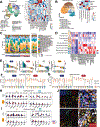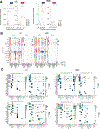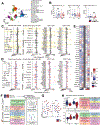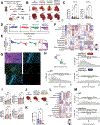Multiomics analysis of immune correlatives in hepatocellular carcinoma patients treated with tremelimumab plus durvalumab
- PMID: 39965889
- PMCID: PMC12392412
- DOI: 10.1136/gutjnl-2024-334026
Multiomics analysis of immune correlatives in hepatocellular carcinoma patients treated with tremelimumab plus durvalumab
Abstract
Background: Hepatocellular carcinoma (HCC) is a leading cause of cancer-related mortality. The combination of tremelimumab and durvalumab is now a standard treatment option for advanced HCC.
Objective: To study immune responses in HCC patients treated with tremelimumab and durvalumab.
Design: We treated 28 HCC patients with durvalumab, tremelimumab and locoregional therapies. We performed a high-dimensional multiomics analysis including whole exome sequencing, single-cell RNA seq, CO-Detection by indEXing, flow cytometry and multiplex cytokine/chemokine analysis of patients' blood and tumour samples and integrated this data to elucidate immune correlatives and response mechanisms. Mice with syngeneic HCC were treated with anti-PD-L1 plus anti-CTLA4 for hepatic lymphocytes, tumour-infiltrating lymphocytes and peripheral blood mononuclear cell analysis.
Results: The median overall survival was 19.2 months. Tumour tissue analysis revealed enhanced interferon responses, with stronger effects in responders. Gene set variation analysis indicated enhanced antigen presentation in responders. Spatial analysis revealed that non-responder tumours had higher numbers of Tregs located in neighbourhoods enriched with immune cells and expressed higher levels of ICOS and PD-1. Conversely, non-responder PD1+CD8+T in these Treg-enriched neighbourhoods expressed lower ICOS. Cell-communication analysis demonstrated that Treg-CD8+T interaction was enhanced in non-responder tissue. Peripheral blood analysis showed increased classical monocytes in responders and Tregs in non-responders. Treg-CD8+T interaction was confirmed in preclinical models. Finally, single-patient computational analysis from the all-across analysis was performed on 860 features, which led to the identification of multiomics feature sets including Treg features.
Conclusion: Our study provides a blueprint for in-depth analysis of immune correlates in immunotherapy studies and demonstrates the importance of Treg distribution in HCC.
Trial registration numbers: NCT02821754 and the EudraCT identifier: 2019-002767-98.
Keywords: CLINICAL TRIALS; HEPATOCELLULAR CARCINOMA; IMMUNOTHERAPY.
© Author(s) (or their employer(s)) 2025. No commercial re-use. See rights and permissions. Published by BMJ Group.
Conflict of interest statement
Competing interests: None declared.
Figures






References
-
- Siegel RL, Miller KD, Wagle NS, et al. Cancer statistics, 2023. CA Cancer J Clin 2023;73:17–48. - PubMed
-
- Singal AG, Kanwal F, Llovet JM. Global trends in hepatocellular carcinoma epidemiology: implications for screening, prevention and therapy. Nat Rev Clin Oncol 2023;20:864–84. - PubMed
-
- Llovet JM, Kelley RK, Villanueva A, et al. Hepatocellular carcinoma. Nat Rev Dis Primers 2021;7:6. - PubMed
-
- Finn RS, Qin S, Ikeda M, et al. Atezolizumab plus Bevacizumab in Unresectable Hepatocellular Carcinoma. N Engl J Med 2020;382:1894–905. - PubMed
-
- Abou-Alfa GK, Lau G, Kudo M, et al. Tremelimumab plus Durvalumab in Unresectable Hepatocellular Carcinoma. NEJM Evid 2022;1:EVIDoa2100070. - PubMed
Publication types
MeSH terms
Substances
Associated data
Grants and funding
LinkOut - more resources
Full Text Sources
Medical
Research Materials
